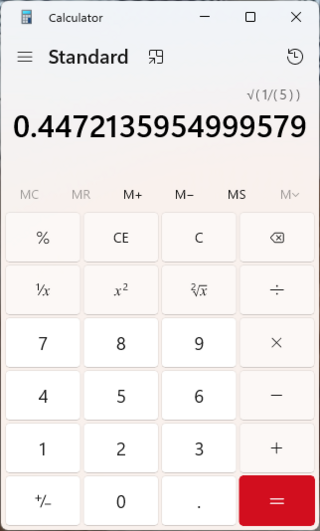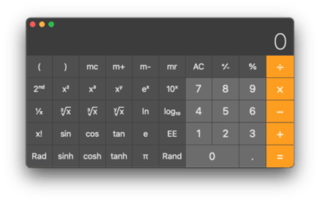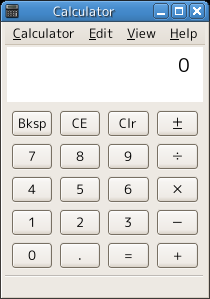Conversion of units is the conversion of the unit of measurement in which a quantity is expressed, typically through a multiplicative conversion factor that changes the unit without changing the quantity. This is also often loosely taken to include replacement of a quantity with a corresponding quantity that describes the same physical property.

An electronic calculator is typically a portable electronic device used to perform calculations, ranging from basic arithmetic to complex mathematics.

A machinist is a tradesperson or trained professional who operates machine tools, and has the ability to set up tools such as milling machines, grinders, lathes, and drilling machines.

A scientific calculator is an electronic calculator, either desktop or handheld, designed to perform calculations using basic and complex mathematical operations and functions. They have completely replaced slide rules as well as books of mathematical tables and are used in both educational and professional settings.

Assessment of kidney function occurs in different ways, using the presence of symptoms and signs, as well as measurements using urine tests, blood tests, and medical imaging.

Windows Calculator is a software calculator developed by Microsoft and included in Windows. In its Windows 10 incarnation it has four modes: standard, scientific, programmer, and a graphing mode. The standard mode includes a number pad and buttons for performing arithmetic operations. The scientific mode takes this a step further and adds exponents and trigonometric function, and programmer mode allows the user to perform operations related to computer programming. In 2020, a graphing mode was added to the Calculator, allowing users to graph equations on a coordinate plane.

The HP-20S (F1890A) is an algebraic programmable scientific calculator produced by Hewlett-Packard from 1987 to 2000.

The HP-27S was a pocket calculator produced by Hewlett-Packard, introduced in 1988, and discontinued between 1990 and 1993. It was the first HP scientific calculator to use algebraic entry instead of RPN, and though it was labelled scientific, it also included features associated with specialized business calculators.

The HP-22S is an electronic calculator from the Hewlett-Packard company which is algebraic and scientific. This calculator is comparable to the HP-32S. A solver was included instead of programming. It had the same constraints as the 32S, lacking enough RAM for serious use. Functions available include TVM and unit conversions. Only single letter variable names are allowed. Marketed as a student calculator, the 22S uses infix notation rather than the reverse polish notation used on some higher-end HP calculators of the same era.

Newton OS is a discontinued operating system for the Apple Newton PDAs produced by Apple Computer, Inc. between 1993 and 1997. It was written entirely in C++ and trimmed to be low power consuming and use the available memory efficiently. Many applications were pre-installed in the ROM of the Newton to save on RAM and flash memory storage for user applications.

The phrase speeds and feeds or feeds and speeds refers to two separate velocities in machine tool practice, cutting speed and feed rate. They are often considered as a pair because of their combined effect on the cutting process. Each, however, can also be considered and analyzed in its own right.
There are various ways in which calculators interpret keystrokes. These can be categorized into two main types:

Calculator is a basic calculator application made by Apple Inc. and bundled with its macOS, iOS, iPadOS, and watchOS operating systems. It has three modes: basic, scientific, and programmer. The basic mode includes a number pad, buttons for adding, subtracting, multiplying, and dividing, as well as memory keys. Scientific mode supports exponents and trigonometric functions. The macOS version of Calculator also has a programmer mode that gives the user access to more options related to computer programming.
Texas Instruments TI-36 is a series of scientific calculators distributed by Texas Instruments. It currently represents the high-end model for the TI-30 product lines.

The HP 35s (F2215A) is a Hewlett-Packard non-graphing programmable scientific calculator. Although it is a successor to the HP 33s, it was introduced to commemorate the 35th anniversary of the HP-35, Hewlett-Packard's first pocket calculator. HP also released a limited production anniversary edition with shiny black overlay and engraving "Celebrating 35 years".
The TI-34 name is a branding used by Texas Instruments for its mid-range scientific calculators aimed at the educational market. The first TI-34 model was introduced in 1987 as a midpoint between the TI-30 series and the TI-35/TI-36 series. Earlier models included Boolean algebra features, though these were removed with the introduction of the TI-34II in 1999, which focuses more on fractional calculations and other subjects common in middle and high school math and science curricula.

A software calculator is a calculator that has been implemented as a computer program, rather than as a physical hardware device.

A formula calculator is a software calculator that can perform a calculation in two steps:
- Enter the calculation by typing it in from the keyboard.
- Press a single button or key to see the final result.
Casio V.P.A.M. calculators are scientific calculators made by Casio which use Casio's Visually Perfect Algebraic Method (V.P.A.M.), Natural Display or Natural V.P.A.M. input methods.

The Casio Algebra FX series was a line of graphing calculators manufactured by Casio Computer Co., Ltd from 1999 to 2003. They were the successor models to the CFX-9970G, the first Casio calculator with computer algebra system, or CAS, a program for symbolic manipulation of mathematical expressions. The calculators were discontinued and succeeded by the Casio ClassPad 300 in 2003.














